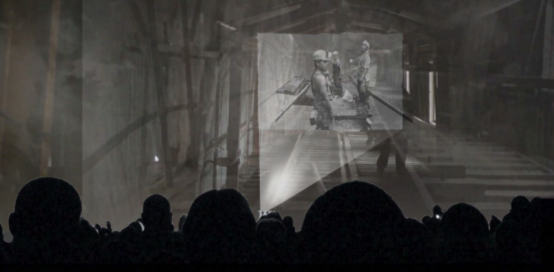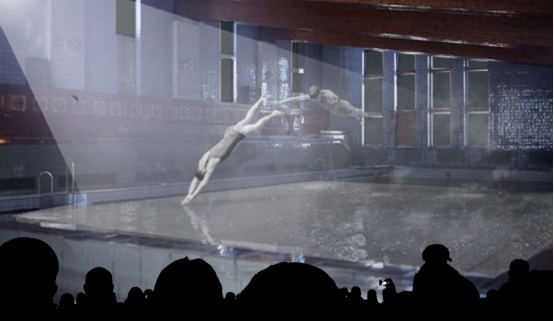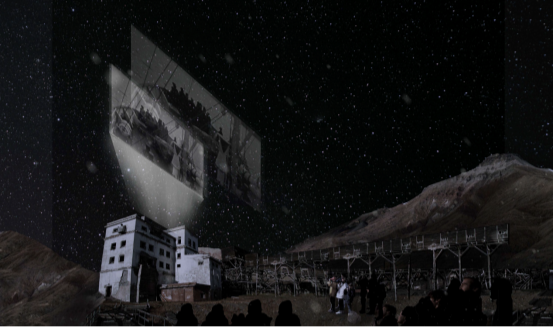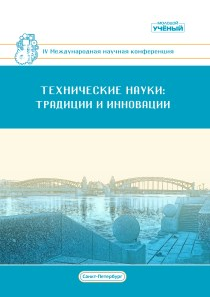Network specifism and co-creation in the digital age: redefining traditional concepts of architectural preservation with immersive experience design
Автор: Плотникова Татьяна Александровна
Рубрика: 16. Новые технические решения
Опубликовано в
Дата публикации: 04.01.2020
Статья просмотрена: 12 раз
Библиографическое описание:
Плотникова, Т. А. Network specifism and co-creation in the digital age: redefining traditional concepts of architectural preservation with immersive experience design / Т. А. Плотникова. — Текст : непосредственный // Технические науки: традиции и инновации : материалы IV Междунар. науч. конф. (г. Санкт-Петербург, январь 2020 г.). — Санкт-Петербург : Свое издательство, 2020. — С. 36-38. — URL: https://moluch.ru/conf/tech/archive/356/15582/ (дата обращения: 25.04.2024).
This paper sets to discuss new formats of design and co-creation. Our lives are becoming heavily informed by technology. It is being incorporated in children’s development from an early age and becomes something that evolves with us and adapts to our needs.
The ongoing plexus of humanity and technology is undeniable. Almost every single person that has a smartphone shares their data with the world; and with the passing of time our digital footprints become capsules of memories stored on the web.
In the past we used to preserve history in the form of sites that have historical value, various artifacts from archeological sites and in the form of information in tangible format — books and music manuscripts. The image of the past was often constructed on the basis of limited sources that in most cases had the same socio-economic status.
In the past, the story was mostly written and passed on as one version of truth, but now we are able to source more information, opinions and perspectives of people that were involved in various degrees (ex. a person who was immediately involved, another one who was an observer etc). The more data we have, the bigger picture we can reconstruct and therefore understand the full complexity. Accepting the fact that there are always multiple truths can help us recreate events in history and encapsulate memories of people with better accuracy.
Technology gave people a stronger voice — it became a tool to connect, express emotions and opinions; it became a personal diary of each and every one of us. With having so much data on our hands comes the power and as well as an amazing opportunity to restore the old and co-create the new.
From physical to sensorial: restoring the old
Why does it make sense to preserve and pass on information in the form of immersive experiences? First of all, it allows to tell multiple stories at the same time, giving a bigger picture to the event. It also allows to move between the scales — going from macro (facts) to micro (personal perceptions). People have a tendency to remember things better that made them feel a certain way, that is why sensorial experiences is a very powerful tool in preserving history.
One of the creative proposals that I was working on was based on the architectural preservation of the settlement Pyramiden on the Island of Svalbard. When I did my research on the settlement, I noticed that it was mostly Soviet block-style housing, located on an island the Arctic Circle, thousands of kilometers away from major cities. It would be close to impossible to tell the history by preserving only the materiality of the settlement. Housing purely served its purpose, it was built for functionality and not aesthetics.
The alternative was to to encapsulate the memory, translate it into a sensorial experience and have an possibility to recreate it anywhere in the world.

Fig. 1. Immersive installation based on real stories, can be recreated anywhere in the world.
Pyramiden has a short but rich history: best scientists of the USSR relocated to the island to work, which meant starting a new life far away from home. The settlement was abandoned within the next 70 years when USSR stopped financing the coal mining activities and residents were forced to leave. Recreating life from scratch and having to abandon it is tragic. Having to reestablish it all over again after such a long time away from home is even harder [1]. Encapsulating the never-ending battle between the past and future, the unceasing flow of gain and loss, love and ephemerality in our lives was only possible through a story — multiple stories of people who lived through those experiences and wanted to share with the world.

Fig. 2. Immersive installation based on real stories, can be recreated anywhere in the world.

Fig. 3. Immersive installation based on real stories, illustrated as an immersive experience on site
From sensorial to digital:
What is Network Specifism and how can we co-create in the digital age?
“Countries around the globe are obsessed by economics and, deluded by the idea that wealth creation embodies high values, have embraced a lifestyle run by computers and informed unquestioningly by mass media. We have lost sight of truly important things in life.” (Tadao Ando, 1999: 106 [2])
Some say that we loose our vision of what is truly important in life because we choose a lifestyle run by technology and mass media that informs our everyday lives. Nevertheless this connection undeniably opens a window to co-creating opportunities.
In essay “Network Specifism: Beyond Critical Regionalism” Carlo Ratti (2013) and his co-authors say that Internet, geo-location, IP locations and URLs is everything in the digital age. According to them, all that affirms “the renewed centrality of place itself within the boundless gaping geographies of virtual and parallel worlds” [3].
Nowadays the connective power of networks has capability to increase connectivity between different people, therefore “provide a new way of mediating between the global and the local” [4]. This includes networks of building users and citizens, networks that link traditional disciplines and networks for design professionals who can work together from across the globe, using synchronized digital tools.
It seems that in the digital age Network Specifism starts to redefine the traditional approach to design, taking it on a new level by integrating almost limitless global connection into design and a number of other disciplines, like network analytic or theoretical ecology. Now design and production can be based not only on the location, but also on the networked community of people that contribute to it.
One of the platforms where such interaction is already happening in a Kickstarter. Throughout the global network, ideas and voices resonate and make different projects feasible. Similar principle has another platform — Brickstarter, but with the focus on the local scale: communities, neighborhoods and cities [3].
This is a special moment in time — design and production is undergoing a contemporary revision. Now, ideas, projects and even then urban fabric of cities can be produced on collective platforms of dynamic exchange and coproduction. Unique and intimate collaborations across ever-present networks open a window to co-creating opportunities, add quality and value to the design. Now technology and the power of networks can work as a tool to create “new places of intimacy and exchange — places without the restrictions of physical space” [5].
Being as connected as never before gives us the power and the opportunity to re-create the old and co-create the new. Network Specifism became a powerful tool in our lives, it allows us to work together without being physically present in one place, enables us to accumulate more information, stay informed on our decisions and produce higher quality projects.
References:
- Nuwer, R. (2014). A Soviet Ghost Town in the Arctic Circle, Pyramiden Stands Alone. [online] Smithsonian Magazine. Available at: https://www.smithsonianmag.com/travel/soviet-ghost-town-arctic-circle-pyramiden-stands-alone-180951429/ [Accessed 25 Dec. 2019].
- Tadao Ando et al. (2007). Essays on Architecture. London: Papadakis Publisher. 105–109.
- Ratti,C., Picon, A., Haw, A. and Claudel, M. (2013). The power of networks. The Architectural Review., 22–23.
- Architectural Review. (2013). Editorial View: Reframing Critical Regionalism for the Current Age. [online] Available at: https://www.architectural-review.com/essays/editorial-view-reframing-critical-regionalism-for-the-current-age/8651301.article [Accessed 26 Dec. 2019].
- Hemment, D., & Townsend, A. (Eds.) (2013). Smart Citizens. Manchester: FutureEverything.
Похожие статьи
Общественное питание в СССР в 1941–1965 гг.: вектор эволюции
В данной статье рассматриваются ключевые проблемы и достижения общественного питания в СССР в условиях Великой Отечественной войны...
Развитие принципа презумпции невиновности в советский...
Статья посвящена анализу правовых аспектов, применения презумпции невиновности в уголовно-процессуальном праве Российской Федерации и СССР.
Constitution — Human Rights | Статья в журнале «Молодой ученый»
The rules prescribed in the constitution adopted in the USSR in 1936 and their place in real life can serve as an example of this kind of constitutions. Secondly, constitutions, according to their forms...
Free trade or protectionism | Статья в журнале «Молодой ученый»
International economic sanctions against the USSR, which followed the introduction of troops into Afghanistan, pursued the goal of ending hostilities and non-interference in the internal affairs of this...
Suggestopaedia as Method by Lozanov | Статья в журнале...
Роль ГУЛАГа в экономике СССР | Статья в сборнике... Economy camp, the USSR , repression. ГУЛАГ (Главное управление исправительно-трудовых лагерей, трудовых поселений и мест...
The distribution of dust storms in the west of Kazakhstan
The treatment of gonorrhea in the former Soviet Union is discussed here on the basis of three typical case histories. 3. Ministry of Health of the USSR. Insctructions and treatment scheme of gonorrhea.
Henry Kissinger and Soviet-American Relations in 1970th
the USSR [1]. Here it is quite just it will be to add influence of human factor, in particular, perception of Kissinger of structure of peace on the that stage. At the end of 1960th he came to the conclusion...
The Study of Althaea officinalis L in scientific resources
In “Flora USSR” 34 types of Alcea L were mentioned. Data given by M.Abdullayeva reveals (1983) that there are 15 types of Alcea L and 5 types of Althaea can be found in central Asian Republics.
О программировании АЦВМ М-1 | Статья в журнале...
В данной статье описывается компьютер М-1 созданный в лаборатории Электросистем Энергетического института АН СССР в 1951 году и предпринята попытка восстановить одну из...
Хрущевская «оттепель» в мультипликации | Статья в журнале...
Статья посвящена описанию методической разработки кружка по теме «СССР в период хрущевской “оттепели”» на основе материалов советской мультипликации.
Похожие статьи
Общественное питание в СССР в 1941–1965 гг.: вектор эволюции
В данной статье рассматриваются ключевые проблемы и достижения общественного питания в СССР в условиях Великой Отечественной войны...
Развитие принципа презумпции невиновности в советский...
Статья посвящена анализу правовых аспектов, применения презумпции невиновности в уголовно-процессуальном праве Российской Федерации и СССР.
Constitution — Human Rights | Статья в журнале «Молодой ученый»
The rules prescribed in the constitution adopted in the USSR in 1936 and their place in real life can serve as an example of this kind of constitutions. Secondly, constitutions, according to their forms...
Free trade or protectionism | Статья в журнале «Молодой ученый»
International economic sanctions against the USSR, which followed the introduction of troops into Afghanistan, pursued the goal of ending hostilities and non-interference in the internal affairs of this...
Suggestopaedia as Method by Lozanov | Статья в журнале...
Роль ГУЛАГа в экономике СССР | Статья в сборнике... Economy camp, the USSR , repression. ГУЛАГ (Главное управление исправительно-трудовых лагерей, трудовых поселений и мест...
The distribution of dust storms in the west of Kazakhstan
The treatment of gonorrhea in the former Soviet Union is discussed here on the basis of three typical case histories. 3. Ministry of Health of the USSR. Insctructions and treatment scheme of gonorrhea.
Henry Kissinger and Soviet-American Relations in 1970th
the USSR [1]. Here it is quite just it will be to add influence of human factor, in particular, perception of Kissinger of structure of peace on the that stage. At the end of 1960th he came to the conclusion...
The Study of Althaea officinalis L in scientific resources
In “Flora USSR” 34 types of Alcea L were mentioned. Data given by M.Abdullayeva reveals (1983) that there are 15 types of Alcea L and 5 types of Althaea can be found in central Asian Republics.
О программировании АЦВМ М-1 | Статья в журнале...
В данной статье описывается компьютер М-1 созданный в лаборатории Электросистем Энергетического института АН СССР в 1951 году и предпринята попытка восстановить одну из...
Хрущевская «оттепель» в мультипликации | Статья в журнале...
Статья посвящена описанию методической разработки кружка по теме «СССР в период хрущевской “оттепели”» на основе материалов советской мультипликации.











